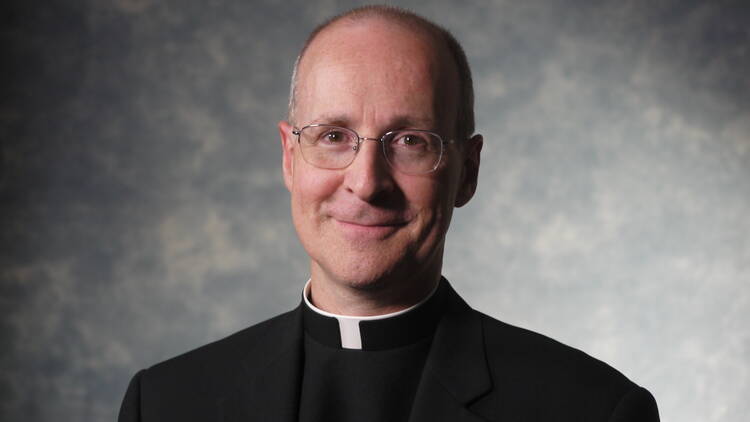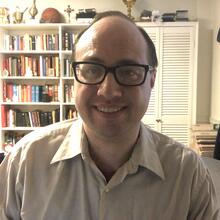James Martin, S.J., is a Jesuit priest and writer who serves as editor-at-large of America.
Father Martin’s writing has appeared in Commonweal, U.S. Catholic, The Tablet, The New York Times, The Wall Street Journal, The Boston Globe, The Chicago Tribune, The Philadelphia Inquirer, O Magazine, Slate.com, The Huffington Post and other venues. He is also a regular commentator on religion and spiritualityfor the major U.S. radio and television networks.
An author of numerous popular works on Ignatian spirituality and Catholic subjects, Father Martin’s most recent books include Seven Last Words: An Invitation to Deeper Friendship with Jesus(2016)andJesus: A Pilgrimage(2016 paperback), as well as his debut novel The Abbey(2015), all available from HarperOne. He is currently working on a book about prayer and is also an active spiritual director.
On June 28, I interviewed Father Martin by email on the topic of Ignatian contemplation.
Contemplation, or contemplative prayer, is a potentially intimidating concept that many Catholics don’t understand. How do you explain it?
First of all, by reminding people that they’re probably doing it already. Without knowing it. Besides, what one spiritual writer calls “contemplation” another calls “meditation” and another calls just plain old “prayer.” Overall, I think that the best definition is that prayer is a conscious conversation with God. That’s a kind of amalgam from William Barry, S.J., and Thomas Green, S.J. Now, Ignatian contemplation, on the other hand, is more specific. That’s using your imagination to place yourself in a scene from Scripture, or with Jesus. It’s more reliant on your imaginative senses, as it were.
Together with contemplation, the Catechism of the Catholic Church talks about vocal prayer (speaking to God, either aloud or in your head, in formulas or your own words) and meditation (reflecting or thinking about something) in describing the three most basic ways of praying. These three ways engage the mouth (vocal), head (meditation) and heart (contemplation) of the believer. How do vocal prayer and meditation relate to contemplation in your own spiritual life?
Vocal prayer is something I use mainly during Mass, when I’m either celebrating or participating with my Jesuit brothers in our community chapel. As a Jesuit, I’m at Mass every day, either at the altar or with the rest of my community in the pews. And vocal prayer can be quite powerful: Sometimes I find that a familiar phrase or even word can take on an entirely new meaning, as if I’d never heard it before. I think, “Where did that come from?” It’s a reminder that God can always surprise.
One form of what I would consider “meditation,” which is a bit less content-heavy than Ignatian contemplation, would be the kind of centering prayer I like to do from time to time, particularly when I’m stressed out. A few years ago I told my spiritual director that my prayer was basically (at that time) just resting in God’s presence, and that I felt a bit guilty about that. That is, it wasn’t more “complex,” or that it wasn’t always Ignatian contemplation. And he said, “Well, you’re a busy person. So maybe God is inviting you into a simple kind of prayer.” That made a lot of sense. It’s a prayer of rest, and that’s fine. St. Thérèse of Lisieux said somewhere that a parent loves the child even when the child is resting—or even asleep! So resting in God’s presence is a lovely way to pray.
Many Catholics believe contemplation is something that only mystics and monks do, so they never go much further than vocal prayer and meditation in their spiritual lives. Others seek out eucharistic adoration and Benediction as a way of easing into it, but not everyone participates in that devotion. What are some more common and simple ways a person might do contemplative prayer?
Well, I’ll use contemplation in the broadest sense. So first, just try imagining yourself in God’s presence. Or sitting beside Jesus. And enjoy it. Then see what happens. What kind of emotions, feelings, memories, desires, insights arise? What might be God trying to tell you with these experiences? Or perhaps God just wants you to enjoy being in the divine presence. Or if you’re a more imaginative person, why not try Ignatian contemplation? Try to imaginatively “place” yourself in a scene from the Gospels. Ask yourself, “What do I see? What do I hear? What do I feel, taste and smell?” And again, see what comes up. Or try lectio divina. Read quietly through a text and see what God wants you to notice. See where that might take you.
There are a lot of ways to begin to pray. Try them out. And don’t get too hung up on the methods and “rules” for each one. Often they overlap. Sometimes people ask: “Am I doing meditation or contemplation or lectio?” And I say, “You’re praying in your own way.”
In your experience, how has contemplation deepened your personal relationship with God?
Immeasurably. For me, the primary way I pray is through Ignatian contemplation. And once you’ve met Jesus in a Gospel scene in your own imagination, nothing is the same. It’s a profound encounter with the living Christ. Remember he’s risen and alive and is present to us through the Spirit, who works through prayer. So you’re truly encountering Christ. It’s also something that completely changes your appreciation of that Gospel passage. So after almost 30 years of praying this way I feel that I know Jesus much better. And I think he knows me better, too!
Based on your experiences of the Spiritual Exercises of St. Ignatius, how would you define Ignatian contemplation, and how does it relate to other forms of contemplative prayer in the church?
Ignatian contemplation is a way of using your imagination to “place” yourself in a scene from Scripture or with Jesus or Mary or God the Father. It’s much more “content heavy” than some other forms of prayer. That is, it really asks you to “compose the place,” as Ignatius says in the Exercises, with as much vividness as possible. So it’s quite specific. It also differs from other kinds of prayer in that it has a pretty clear structure: first this, then that, then this. Ignatius wasn’t a military guy for nothing!
Now of course it should be pointed out that Ignatius didn’t invent this. If anything, St. Francis of Assisi, who encouraged people to pray with the Christmas crèche, predated this. But you could say Ignatius and the Jesuits popularized it.
How would you describe the method of Ignatian contemplation as you use it in your own life?
Oh it’s very simple, and pretty traditional. First, I look at where I’m going to pray (something Ignatius recommends: actually looking at the chair or pew and imagining God looking at you). It’s a way of remembering that prayer is not just you in your own head. Then I ask God again to be with me. Then I just close my eyes, and try to “compose the place,” imagining the scene with my interior senses, and then I let God take the lead. Usually I’m using the Daily Mass readings, almost always the Gospel reading. And then I let God take me where God wants to go.
Usually this kind of prayer is most effective on retreat—when I’m also using the readings suggested by my retreat director. But during the rest of the year, sometimes it doesn’t feel like much is happening. I’ve learned to get used to that. That’s part of the ups and downs of the spiritual life.
Because Ignatian contemplation relies on exercises of the imagination as a means to contemplating God, some beginners confuse the imaginative part of the prayer with the contemplation itself to which it leads. How do you distinguish between the imagination as a means to contemplation and the contemplation in itself?
Well, I try not to get too bogged down in those kinds of distinctions, Jesuit as they may be. For me, and for so many of my directees and people I see on retreat, the lines are usually not so clear cut. The kinds of things that come up in the “composition of place” (that is, what you notice in that scene) really are a kind of contemplation. So if I’m imagining being in a Gospel scene with Jesus, is that my imagination or is that contemplation? And I would say both. Because God is at work through your imagination. And really who is to say where one ends and the other begins? For me it’s more fluid.
Beginners in Ignatian contemplation sometimes struggle to distinguish between what comes from God and what comes from their own heads when they use their imagination to pray. As a spiritual director and retreat master, what do you say to them?
Ah, good question! Not everything that pops into your mind is from God, of course. But usually, it’s easy to tell. Anything that draws you deeper into prayer, helps you feel closer to God, or, as Ignatius says, builds you up, encourages you, gives you hope, is probably coming from God. God’s voice also has the ring of authenticity. Usually, when good people are praying, in my experience, what happens in their prayer is from God. And in time it gets easier to discern. Of course, a good spiritual director is helpful.
Many Catholics want to go deeper in prayer but lack resources to get started. What do you recommend for a beginner in contemplative prayer?
You can try my book The Jesuit Guide to (Almost) Everything, which talks a lot about prayer. Also, one of my favorite books is God and You: Prayer as a Personal Relationship, by William Barry, S.J. Other books I return to over and over are Armchair Mystic, by Mark Thibodeaux, S.J., and Opening to God, by Thomas Green, S.J. And sometimes I just like books that “spark” prayer, like Woman Un-Bent by Irene Zimmerman, O.S.F., and Fragments of Your Ancient Name, by Joyce Rupp, O.S.M. They are not “how to” books about prayer, but they’ll help you to pray.
But even better than prayer, try a weekend retreat. There’s nothing like a good spiritual director and a good retreat! And there is probably a Jesuit retreat house in your area.
What other advice would you give to someone about Ignatian contemplation?
Try it. Don’t be upset if it doesn’t seem to “work” right away. Give it some time. Then try it again. Don’t have too many expectations. And if after trying it for some time, you don’t like it, don’t worry about it too much. There is no right way to pray. Not everyone likes Ignatian contemplation.
Any final thoughts?
Yes. God will meet you where you are. So not everyone will like Ignatian contemplation. That’s okay. You might like lectio divina better. Or adoration of the Blessed Sacrament. Or the rosary. Or centering prayer. Or your own form of prayer. The best way to pray is the way that you feel brings you closest to God. Also, throw in a prayer for me when you can!
Sean Salai, S.J., is a contributing writer at America.








Thank you all for reading. Let's continue to pray for a deepening relationship with God.